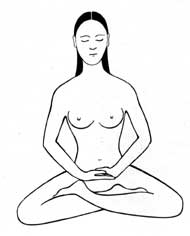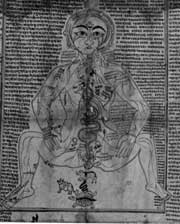|
|
|

|
KUNDALINI
THE AROUSAL OF KUNDALINI |
|
|
|
| Kundalini is aroused through
‘sense with drawal or pratyahara, concentrating all his attention on a single
point (dharana) until normal mental activity is totally suspended. The
will-power is directed inwards to the vital air (Prana) that is inhaled and
held in Pranayama guiding its circulatory movement through ida and ida and
pingala down to the base of the spine into the space where Kundalini lies
coiled. The entry of Prana produces an abrupt effect like sudden combustion in
a confined space, and its trance-sleep (yoga-nidra). This discipline of
psychosomatic regulation and breath-control is the contribution of
kundalini-yoga to tantric ritual. Pranayama reinforces the power of meditative
practices, and it is upon this technique that the Tantras lay the strongest
emphasis.
|
|
 |
Breath provides the means of symbiosis between
different forms of life and also between existence and awareness. Yoga is
concerned to direct this bio-motor force towards the expansion of consciousness
in the human organism. It is through the science of breathing that the body’s
subtle centers are vitalized. Yoga has developed systematic techniques of
breathing, regulating its speed, depth and rhythm. In normal circumstances
lation shallow but they lack harmony. While every individual’s respiratory
cycle reacts dynamically upon the latent kundalini a reaction that takes place
about 21,600 times a day, that is at a frequency more or less equal to the
individual’s number of breaths this respiration is shallow and rapid, filling
the lungs to only a fraction of their capacity, and supplying a current of
oxygenated energy flowing downwards to strike kundalini that is wholly
inadequate to awaken her.
|
|
|
| Yogananda in his autobiography,
while narrating his guru’s explanation that the ancient yogis discovered the
secret of the link between cosmic consciousness and breath-mastery writes that:
The kriya yogi mentally directs his life energy to revolve upward and downward,
around the six spinal centers (medullary, cervical dorsal, lumbar sacral and
coccygeal plexuses), which correspond to the twelve astral signs of the zodiac,
the symbolic Cosmic Man. One half – minute of revolution of energy around the
sensitive spinal cord of man affects subtle progress in his evolution that
half-minute of kriya equals one year of natural spiritual unfoldment.
|
|
| Pranayama is reinforced by such yogic practices
as asanas (sustained postures), mudras (gestures), mantras (seed-sound
syllables) and bandhas (internal lock or muscular contraction). A compact and
relaxed bodily position that may be sustained for long periods is first
adopted. In padamasana, the lotus posture one sits cross legged with the right
foot resting on the left thigh and the left foot crossed over the right leg; in
Siddhasana the posture of accomplish-ment the left heel is pressed firmly on
the perineum and the heel of the right foot is placed on the left thigh
touching the abdomen. In both these positions, the body is upright with the
head neck and spinal column balanced naturally on their axis. The eyes are
directed towards the tip of the nose for deep concentration while the hands are
laid on the knees. Yogis explain that sitting cross-legged in either of these |
 |
|
|
| postures provides a stable
triangular base which sustains the closed circuit of the energy field. The
first step in Pranayama is to regulate the breathing. Rhythm is all-important
as it is this that supports concentration and harnesses the impulse of the
autonomic nervous system. By taking deeper and fuller breaths we begin to
absorb the maximum pranic current with each inhalation. To proceed further a
knowledge of the phasing of respiration’s units is required. Each unit consists
of three parts: inhalation retention of breath at any point during inhalation
the chief method of absorbing energy from the atmosphere; and exhalation of the
used air. Balanced rhythm in breathing depends on achieving the correct ratio
between these three units. The ideal phasing of inhalation (puraka), retention
(kumbhaka) and exhalation (rechaka) is 1:4:2. |
|
 |
The air is inhaled slowly through the left
nostril (which is connected with the lunar channel ida) while the right nostril
is closed with the thumb. The breath is then held while meditating on the
seed-sound syllable yam, and exhaled in the correct rhythm. The same procedure
is repeated using the right nostril (which is connected with the solar channel,
pingala) and the seed-sound syllable ram. Ida and pingala as they rise from the
region of the coccyx entwine around the sushumna, crossing from side to side at
nodes between the chakras. (it is interesting to note that the same spiral
pattern is seen in the double-helix configuration of the DNA-molecule
containing the genetic code of life.) |
|
|
| In the practice of Pranayama,
these pathways are purified (cleansing of the nadis) to allow the free flow of
psychic forces. During this yogic discipline, the primal sound Om (A-U-M), or a
similar seed-sound syllable drawn from the Sanskrit alphabet is uttered
repeatedly, not only as a measure of duration but to provide a sound-vibration
which has a connection with the subtle channels and chakras; for each chakra
has a corresponding sound and colour vibrating at different frequencies.
Starting with the root chakra and working up to the top of the head, these
vibration-rates are given by the Tantric texts as 4, 6, 10, 12, 16, 2, 1,000;
and the number of rays, of tattvas (subtle elements) has been mentioned as 56
for Muladhara, 62 for Svadhisthana, 52 for Manipura 54 for Anahata, 72 for
Visuddha and 64 for Ajna. One of the vital airs of prana is the Apana, which
controls the situation it occupies below the navel region. It is associated
with the colours purple and orange, and is linked from below with the fire
element. Purple and orange, and is linked from below with the fire element.
According to the yoga kundalini Upanishad (42-46), when one causes the downward
Apana to move upwards [by constriction of the sphincter muscles of the rectum],
it is known as of the fire [element], the flame of fire, caused by the vital
air [Prana] to ascend, increases its intensity. When the fire and Apana reach
the heated prana a current is generated in the body. by that current the
sleeping Kundalini being very much heated, is roused, and like a snake
belaboured with a stick becomes erect with hissing and by way of entering its
hole, reaches the interior of the Brahma-nadi. |
|
| Each of the chakras, according to
the Tantras, corresponds to one to the elements of which the known world is
compounded, and of which the individual constitution is but a simulacrum.
Muladhara represents solidity; Svadhisthana, liquidity; Manipura, the gaseous;
Anahata the aerial; Visuddha, the etheric, or space. One can see the whole
process as a progressive transformation of the elements, with an increase of
volatility. |
|
| In the Visuddha centre, of space
(akasa), the principle of vacuity. There one steps beyond the empirical world;
as it were beyond the ‘world of concepts’. C.G. jung, using the language of
archetypes (or the residual images retained in the collective unconscious that
surface in dreams, in myths, and in the creative psyche), has suggested the
mandala or cone of experience by which to visualize this journey. He sees it as
a spiral climb inwards and upwards from the circumference of the sphere of the
base of the cone into the point-experience or crest-experience at the center of
being.
|
|
| A dynamization, transformation and
sublimation of the physical, mental, and spiritual state is only possible with
the arousal of the Kundalini Sakti and her reorientation from downward to
upward movement as she rises to unite with Siva, resulting in the flooding of
the whole being with indescribable bliss. The aspirant raises himself from the
grosser elements to the subtler, and realizes, in a transcendental experience,
his union with Siva-Sakti, to become a ‘cosmic man’.
|
|
|
|
|
|